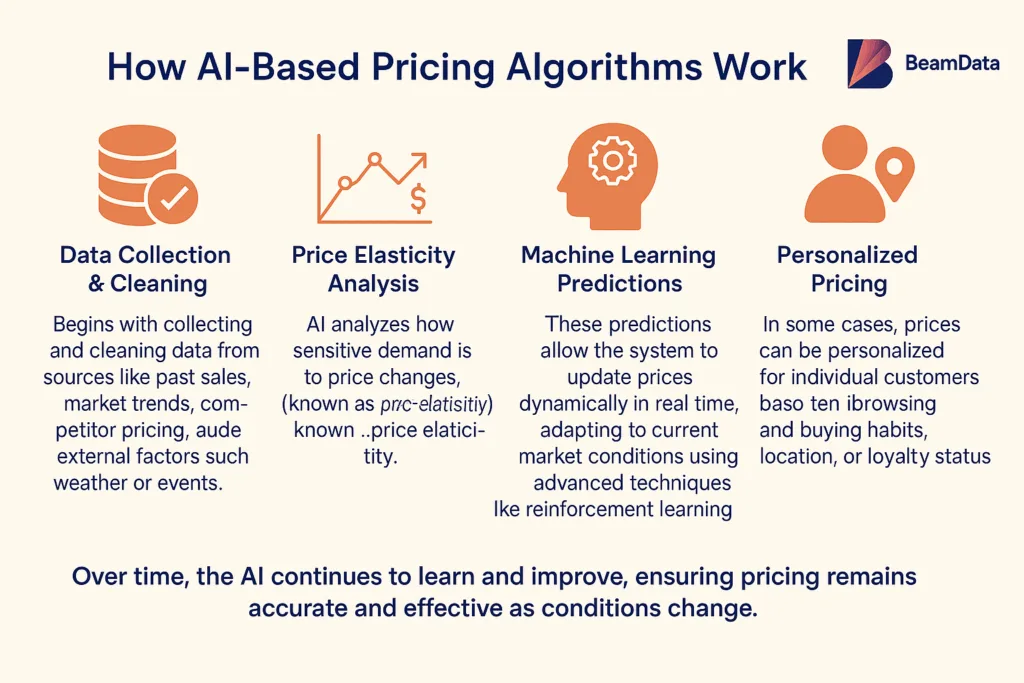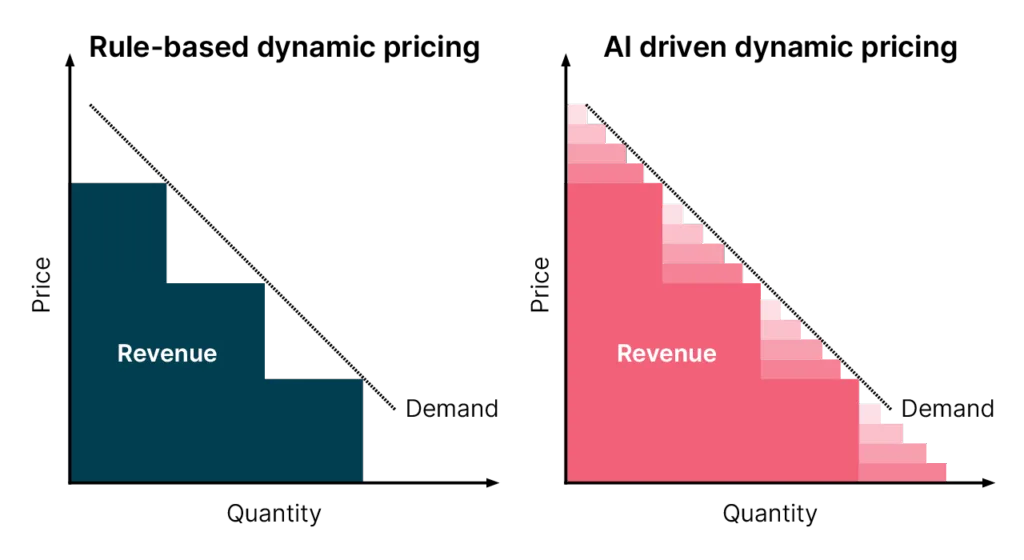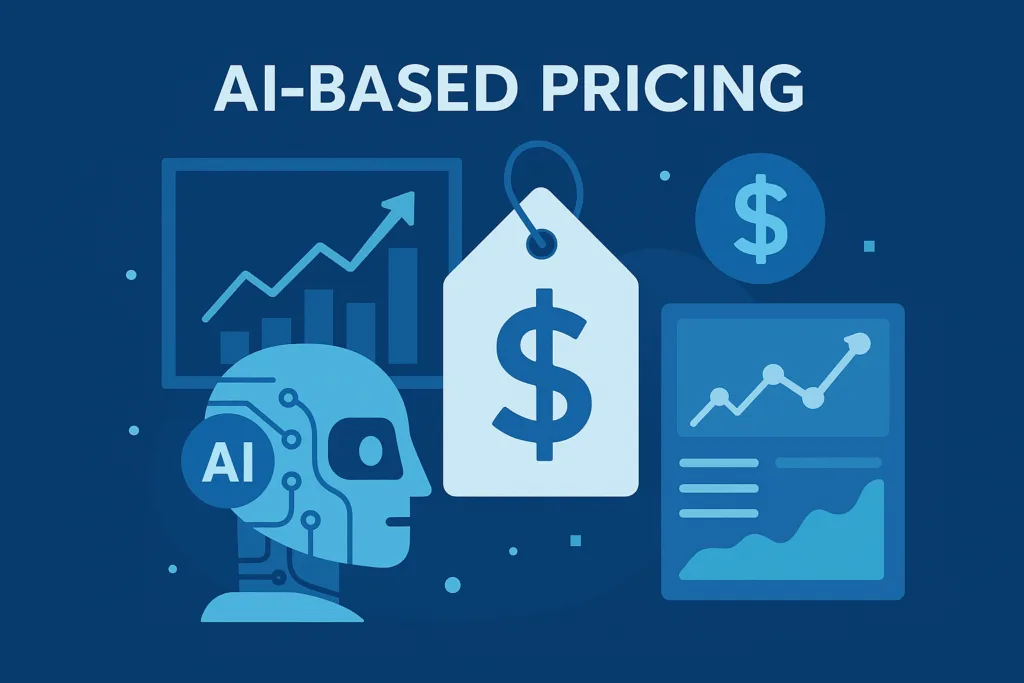In boardrooms across industries, executives scrutinize every line item, yet one of the most overlooked growth levers sits quietly in plain sight: pricing. Despite its direct impact on revenue and margins, many companies still rely on outdated, manual pricing strategies that leak profits daily. If your pricing hasn’t evolved with your customers or your market, you could be leaving 1–5% of revenue untapped. Your solution? AI based pricing.
Artificial Intelligence (AI) is rewriting the rules of pricing strategy. AI based pricing doesn’t just automate—it optimizes in real time, adapting to customer behavior, market trends, and competitor moves.
In this article, we’ll explore how AI based pricing helps organizations uncover hidden revenue, improve profitability, and future-proof their pricing models.
Hidden costs of Traditional Pricing Models
Traditional pricing approaches, often reliant on spreadsheets or legacy ERP systems, are ill-equipped to respond swiftly to market changes. Common challenges include:
- Static price lists that ignore real-time market fluctuations
- Manual updates susceptible to errors and delays
- Inconsistent pricing across regions or customer segments
These issues can result in missed upsell opportunities, underpriced products, and misaligned discounts, all of which erode potential profits.
How AI Based Pricing Algorithms Work
AI based pricing algorithms work by analyzing large amounts of data to help businesses set prices that align with their goals—whether that’s increasing revenue, maximizing profit, or retaining customers. The process begins with collecting and cleaning data from sources like past sales, market trends, competitor pricing, customer behavior, and external factors such as weather or events. The AI then analyzes how sensitive demand is to price changes (known as price elasticity) and uses machine learning to predict how different prices will impact sales and profitability. These predictions allow the system to update prices dynamically in real time, adapting to current market conditions using advanced techniques like reinforcement learning. In some cases, prices can even be personalized for individual customers based on their browsing and buying habits, location, or loyalty status. Over time, the AI continues to learn and improve, ensuring pricing remains accurate and effective as conditions change.

How does AI Dynamic Pricing help companies?
AI based pricing transforms into a dynamic, data-driven process that operates continuously. Key benefits include:
- Real-Time Analysis: AI processes data from customer behaviors, competitor pricing, inventory levels, and demand trends.
- Predictive Modeling: It forecasts future buying patterns and price sensitivities.
- Dynamic Adjustments: AI algorithms modify prices in real-time to maximize value from each transaction.
For instance, AI can increase the price of a high-demand item in a specific region while offering personalized discounts to price-sensitive customers elsewhere.

Quantifying the Impact: AI based pricing ROI
Implementing AI based pricing strategies can yield significant returns:
- 1–5% Revenue Growth: Achieved without new product launches or market expansion.
- 10–20% Increase in Customer Lifetime Value (CLV): Through personalized pricing and improved retention.
- 20–30% Higher Sales Conversions: Driven by targeted, dynamic pricing strategies.
These figures underscore the strategic advantage of aligning pricing with enterprise growth objectives.
Rapid Revenue Gains Across Industries
AI-powered pricing delivers quick wins across various sectors:
- Retail & E-Commerce: Implementing AI based dynamic pricing based on inventory levels, competitor actions, and demand surges.
- Manufacturing: Utilizing elasticity-based pricing that adjusts by product category, distribution channel, and raw material costs.
- B2B Services: Generating custom quotes based on customer history, contract terms, and current market conditions.
- Travel & Logistics: Applying dynamic route pricing influenced by time-of-day, capacity, and fuel prices.
These applications often deliver measurable ROI within the first quarter post-implementation.
Strategic Advantages for Leadership
AI based pricing serves as a strategic enabler across executive roles:
- CFOs: Maximize revenue and margins with minimal customer churn.
- CMOs: Enhance customer satisfaction and lifetime value through intelligent segmentation and offers.
- COOs: Improve process efficiency and reduce manual overhead.
- CEOs: Demonstrate innovation and a data-driven culture to investors and partners.
By transforming pricing from an operational task to a strategic asset, AI based pricing empowers leadership to drive growth.
Implementing AI based pricing: A Step-by-Step Guide
Adopting AI based pricing doesn’t necessitate an enterprise-wide overhaul. A phased approach ensures success:
- Identify High-Impact Areas: Target SKUs, customer segments, or markets ripe for optimization.
- Pilot an AI Engine: Test algorithms in a controlled environment to benchmark performance.
- Integrate Systems: Connect AI pricing tools to existing CRM, ERP, and POS systems.
- Train Users: Educate teams on interpreting AI based pricing insights and making informed decisions.
- Monitor and Scale: Measure key performance indicators, refine models, and expand implementation.
This approach facilitates seamless integration and maximizes the benefits of AI based pricing.
Avoiding Common Pitfalls for AI based pricing
To ensure successful AI based pricing implementation, be mindful of potential challenges:
- Data Quality: Ensure accurate and comprehensive data inputs.
- Model Transparency: Maintain clarity in AI decision-making processes to build trust.
- Change Management: Foster cross-functional buy-in and provide adequate training.
Addressing these areas proactively will enhance the effectiveness of your AI pricing strategy.
Beam Data: Your Partner in AI Pricing Optimization
Based in North America, Beam Data specializes in delivering AI pricing solutions that are:
- Tailored: Customized to address industry-specific pricing challenges.
- Transparent: Offering clear logic and control over pricing rules and elasticity models.
- Integrated: Compatible with existing technology stacks, eliminating the need for complete system overhauls.
- Scalable: Designed to grow with your business, from pilot projects to enterprise-wide deployment.
We collaborate closely with clients to transform AI based pricing into a powerful growth engine.
Transform Pricing into a Strategic Advantage
AI-powered pricing strategies offer a transformative opportunity to unlock hidden revenue, enhance profitability, and gain a competitive edge. By moving beyond static pricing models and embracing dynamic, data-driven approaches, businesses can align pricing with broader growth objectives.
Ready to revolutionize your pricing strategy? Partner with Beam Data to harness the power of AI and discover the untapped revenue potential within your existing operations. Beam Data has partnered over a range of companies to successfully integrate customized AI solutions into their operations.
Every business is different—and so are its data challenges. At BeamData, we don’t just offer standard solutions. Our team works closely with you to design custom data pipelines and AI workflows tailored to your specific goals. Whether you’re dealing with complex data sources or unique AI use cases, we build solutions that fit, not force.
FAQs
How quickly can AI pricing models be implemented?
Many companies launch a pilot within 6–8 weeks and observe measurable results in under 90 days.
Is AI based pricing suitable for all industries?
Yes, sectors such as retail, manufacturing, logistics, and B2B services have successfully adopted AI based pricing strategies.
How does AI based pricing affect customer trust and perception?
With transparent and fair pricing models, AI can enhance perceived value and customer satisfaction. AI based pricing also helps keeps your product and service competitive in line of the market conditions.
What kind of data is required to get started?
Historical pricing, sales volumes, customer segmentation, and competitive benchmarks are ideal starting points to create your own model of AI based pricing.
Can AI based pricing integrate with existing ERP or sales platforms?
Absolutely. Beam Data supports integrations with systems like SAP, Salesforce, Oracle, and more so the best version of AI based pricing is available for your company usage.



